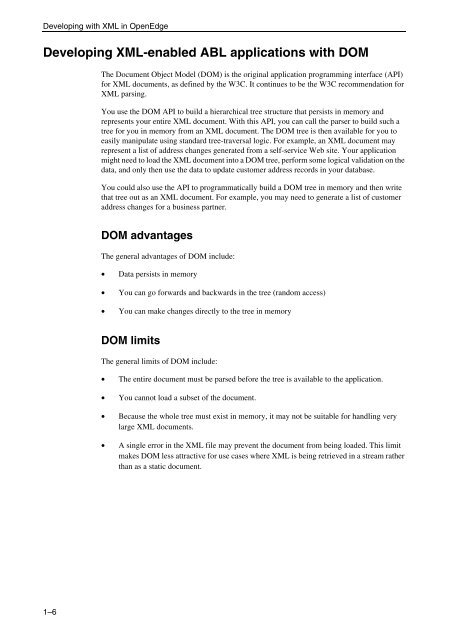OpenEdge Development: Working with XML - Product ...
OpenEdge Development: Working with XML - Product ...
OpenEdge Development: Working with XML - Product ...
Create successful ePaper yourself
Turn your PDF publications into a flip-book with our unique Google optimized e-Paper software.
Developing <strong>with</strong> <strong>XML</strong> in <strong>OpenEdge</strong><br />
Developing <strong>XML</strong>-enabled ABL applications <strong>with</strong> DOM<br />
1–6<br />
The Document Object Model (DOM) is the original application programming interface (API)<br />
for <strong>XML</strong> documents, as defined by the W3C. It continues to be the W3C recommendation for<br />
<strong>XML</strong> parsing.<br />
You use the DOM API to build a hierarchical tree structure that persists in memory and<br />
represents your entire <strong>XML</strong> document. With this API, you can call the parser to build such a<br />
tree for you in memory from an <strong>XML</strong> document. The DOM tree is then available for you to<br />
easily manipulate using standard tree-traversal logic. For example, an <strong>XML</strong> document may<br />
represent a list of address changes generated from a self-service Web site. Your application<br />
might need to load the <strong>XML</strong> document into a DOM tree, perform some logical validation on the<br />
data, and only then use the data to update customer address records in your database.<br />
You could also use the API to programmatically build a DOM tree in memory and then write<br />
that tree out as an <strong>XML</strong> document. For example, you may need to generate a list of customer<br />
address changes for a business partner.<br />
DOM advantages<br />
The general advantages of DOM include:<br />
• Data persists in memory<br />
• You can go forwards and backwards in the tree (random access)<br />
• You can make changes directly to the tree in memory<br />
DOM limits<br />
The general limits of DOM include:<br />
• The entire document must be parsed before the tree is available to the application.<br />
• You cannot load a subset of the document.<br />
• Because the whole tree must exist in memory, it may not be suitable for handling very<br />
large <strong>XML</strong> documents.<br />
• A single error in the <strong>XML</strong> file may prevent the document from being loaded. This limit<br />
makes DOM less attractive for use cases where <strong>XML</strong> is being retrieved in a stream rather<br />
than as a static document.
















